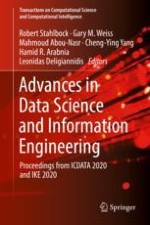The book presents the proceedings of two conferences: the 16th International Conference on Data Science (ICDATA 2020) and the 19th International Conference on Information & Knowledge Engineering (IKE 2020), which took place in Las Vegas, NV, USA, July 27-30, 2020. The conferences are part of the larger 2020 World Congress in Computer Science, Computer Engineering, & Applied Computing (CSCE'20), which features 20 major tracks. Papers cover all aspects of Data Science, Data Mining, Machine Learning, Artificial and Computational Intelligence (ICDATA) and Information Retrieval Systems, Information & Knowledge Engineering, Management and Cyber-Learning (IKE). Authors include academics, researchers, professionals, and students.
Presents the proceedings of the 16th International Conference on Data Science (ICDATA 2020) and the 19th International Conference on Information & Knowledge Engineering (IKE 2020); Includes papers on topics from data mining to machine learning to informational retrieval systems;Authors include academics, researchers, professionals and students.
